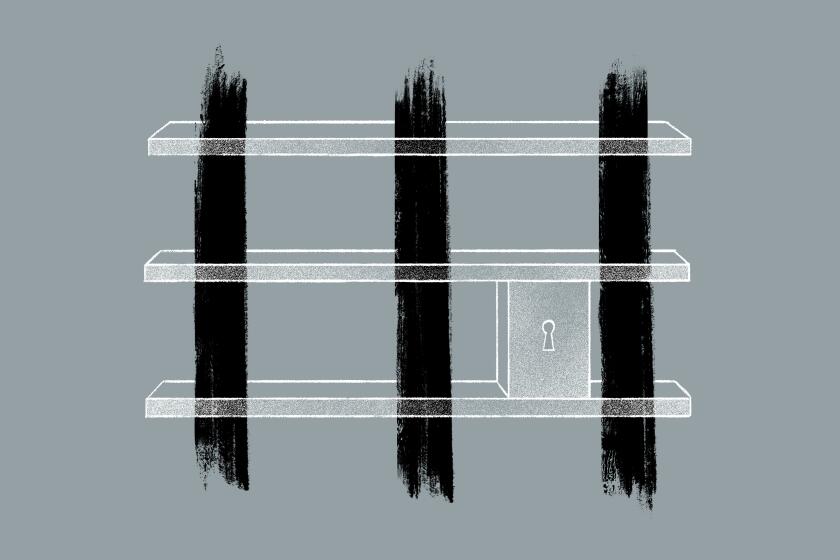
- Share via
When 12-year-old Polly Klaas was kidnapped by a stranger from her Northern California home on Oct. 1, 1993, the efforts to find her drew worldwide attention. When Polly’s body was found 64 nights after her abduction, the outpouring of grief in her hometown and beyond was overwhelming.
Why had Polly’s case so profoundly touched the nation and the world? Eve Nichol, Polly’s mom, didn’t know. She realized not every family receives this kind of support. But she hoped that what had been learned from Polly’s case would help galvanize some other community in the future. If Polly’s fate could change laws or inspire efforts to prevent child abuse, perhaps “something good can come out of this horror,” she thought.
In fact, the Klaas investigation would become a Hall of Fame case in the Federal Bureau of Investigation’s San Francisco division.
California has seen the damage harsh sentencing laws produce. Proposition 20 would strike a blow to justice in the state.
“The case was immensely important to us at the time and was followed very closely,” said former FBI Director Louis J. Freeh, who implemented a bureau‑wide Crimes Against Children program during his tenure. Members of the Klaas investigative team played a key role in that nationwide effort and used insights gleaned from the case to improve the bureau’s response to child abductions. Mary Ellen O’Toole, the FBI profiler who worked the case, later wrote the FBI’s official kidnapping protocol.
The Klaas investigation didn’t just inform the ways we search for and find missing children, but also the way the FBI investigates many other types of crime. Investigative methods tested and proved in this case forever transformed the bureau’s approach to crime scene investigation, forensics, behavioral science, rapid response and kidnapping protocols.
For example, this case marked the FBI’s first use of fluorescent powder and alternate light sources. These tools proved their value by identifying the latent palm print on Polly’s bunk bed frame, fibers linking four crime scenes, and other evidence essential to the arrest and conviction of Richard Allen Davis, Polly’s kidnapper and killer, who was sentenced to death and currently resides on death row in San Quentin.
Polly Klaas’ sisters are pushing back against laws that were passed in her name after she was murdered in 1993. They want to alter that legacy.
On the day of Polly’s memorial, Assistant Special Agent in Charge Mark Mershon got a call from Quantico, Va., with good news: Based on the results of Polly’s case, FBI headquarters had earmarked money to purchase alternate light sources. At a cost of $8,000 per unit, this was a major investment and a big win for a new approach to investigations with the use of an “evidence response team.”
The Klaas investigation was the first major case to be run by such a team in the FBI. Based in the Bay Area, it proved the effectiveness of quick‑responding local teams trained to process crime scenes, gather trace evidence and work closely with the FBI lab. The evidence response team model was subsequently adopted bureau‑wide. Members of the San Francisco team would apply skills and lessons forged in the Klaas case to a number of other cases including the Unabomber, the Oklahoma City bombing and the 2001 World Trade Center attacks.
Today, the FBI has more than 1,000 evidence response team members, and each geographic division has its own dedicated team.
Though criminal justice reforms have emphasized rehabilitation over long sentences in recent years, for those convicted in harsher eras, second chances are hard to come by.
The Klaas case also marked the first time an FBI profiler was embedded with an evidence response team. The profiler in Polly’s case worked side by side with the team to combine behavioral science with forensic science. This approach would be repeated in other high‑profile cases such as the kidnapping of Elizabeth Smart and the disappearance of Natalee Holloway.
Some of the tragic twists of the Klaas case were used to spur big changes. Communication between federal and local law enforcement officials was streamlined and improved. Computers were put in patrol cars, so officers could look up a suspect’s prior arrests and convictions in real time.
One of the biggest lessons of the case — the handling of child witnesses — inspired major changes. Today, child witnesses and victims are interviewed by trained experts, a major investigative change that accelerated after the Klaas investigation.
In 1996, the American Professional Society on the Abuse of Children held the nation’s first child forensic interviewing clinic. A new kind of specialist emerged: child and adolescent forensic interviewers. Though they work closely with law enforcement agencies, these interviewers are typically civilians trained through an internationally recognized, research‑based curriculum developed by the National Children’s Advocacy Center.
Child and adolescent forensic interviewers use research‑based protocols for interviewing young witnesses and victims. The interviews take place in “soft rooms” with cozy love seats, child‑sized coloring tables and artwork on the walls. Their protocols emphasize free narratives — “Start at the beginning and go all the way to the end ...” — instead of interrogation‑style questions and interruptions for clarification. Their policy prohibits polygraph tests and starts with the assumption that the witness is being truthful.
Today, the FBI has a Child Victim Services program that supports children who are victimized or who witness federal crimes, and also trains local law enforcement in how to treat them properly. Their coordinators work to ensure that any interviews and interactions are tailored to minimize additional trauma and are appropriate for the child’s developmental stage.
The FBI program has grown from three child and adolescent forensic interviewers in 2001 to 22 interviewers and three supervisors in 2023. The unit chief has conducted more than 10,000 interviews.
Polly’s kidnapping also influenced changes outside of law enforcement. Suburban America was starting to feel unsafe, a trend that started before Polly Klaas and escalated after her death. “Stranger danger” — real and perceived — triggered a major shift in social behavior in the 1990s and beyond. Neighborhood parks and playgrounds began to see fewer kids. Families installed alarm systems or adopted a guard dog. Children were kept inside on sunny days, no longer allowed to walk a few blocks to the corner store or a friend’s house. Staying home and playing video games felt like a safer alternative. The days of free‑range childhood were vanishing.
“This used to be a good little town,” said a 12-year‑old girl who had acted with Polly in a local production of “Annie.” “Now it’s ... I don’t know what.” Whether she was parroting her parents or truly aware of this major shift, her sentiment reflected what people were feeling in Petaluma — and nationwide. As one local high schooler put it, “All the kids around here, they’re scared to go out and play.”
The day after Polly’s memorial, in a suburb of St. Louis, a group of children stumbled upon the body of a slain 10‑year‑old girl. Cassidy Senter was the second victim of a suspected child serial killer, and parents were terrified. They started patrolling neighborhood streets that had once felt safe. Kids were afraid. Parents were afraid. One 21‑year‑old woman was afraid to take out the trash. “We’re all in a quiet state of panic,” said a mother of two. “I don’t know how much more of this we can take.”
This atmosphere of public fear became an incubator for public policies that would change the nature of crime and punishment in America.
Kim Cross is a journalist, historian and bestselling author. This article is an adapted excerpt from her book “In the Light of All Darkness: Inside the Polly Klaas Kidnapping and the Search for America’s Child,” which will be published Oct. 3.
More to Read
A cure for the common opinion
Get thought-provoking perspectives with our weekly newsletter.
You may occasionally receive promotional content from the Los Angeles Times.











